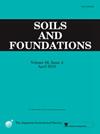上拔荷载作用下螺旋桩承载力预测方法
IF 3.3
2区 工程技术
Q2 ENGINEERING, GEOLOGICAL
引用次数: 0
摘要
螺纹沿桩面连续分布,极大地改变了其承载机理,使其区别于传统柱桩。目前,螺旋桩抗拔承载力的计算方法尚不完善。提出了一种基于分段位移协调迭代法的螺旋桩抗拔承载力计算方法,以及一种基于交汇收敛法的螺旋桩抗拔承载力极限预测方法。通过模型和现场试验验证了这些方法的准确性。运用这些理论计算和预测方法,分析了螺旋桩的抗拔承载特性及其影响因素。结果表明:与柱桩相比,螺旋桩独特的螺纹结构显著提高了其抗拔承载力;螺旋桩的P-s曲线呈现缓慢变化特征,在极限承载状态下,桩身阻力主要由较深土层提供。随着螺距的增大,螺旋桩的极限抗拔承载力先上升后下降,当螺距等于第二个临界螺距时达到最大值。随着内摩擦角的增大,螺旋桩的抗拔能力明显优于柱桩。本文章由计算机程序翻译,如有差异,请以英文原文为准。
Prediction method of screw pile bearing capacity under uplift load
The screw threads continuously distributed along the surface of the pile significantly modify its bearing mechanism, distinguishing it from traditional column piles. Currently, methods for calculating the uplift bearing capacity of screw piles remain underdeveloped. This study presents a calculation method for the uplift bearing capacity of screw piles based on the segmented displacement coordination iterative method, as well as a prediction method for the ultimate uplift bearing capacity using the intersection convergence method. The accuracy of these methods was validated through model and field tests. Using these theoretical calculation and prediction methods, the uplift bearing characteristics and influencing factors of screw piles were analyzed. The results demonstrated that the unique screw thread structure of screw piles significantly enhances their uplift bearing capacity compared to column piles. The P-s curve of screw piles exhibits a slow variation characteristic, and under ultimate bearing state, the shaft resistance is primarily provided by the deeper soil layers. The ultimate uplift bearing capacity of screw piles rises initially and declines as the screw pitch increases, reaching its maximum value when the screw pitch equals the second critical screw pitch. Furthermore, as the internal friction angle increases, screw piles outperform column piles more significantly in uplift capacity.
求助全文
通过发布文献求助,成功后即可免费获取论文全文。
去求助
来源期刊

Soils and Foundations
工程技术-地球科学综合
CiteScore
6.40
自引率
8.10%
发文量
99
审稿时长
5 months
期刊介绍:
Soils and Foundations is one of the leading journals in the field of soil mechanics and geotechnical engineering. It is the official journal of the Japanese Geotechnical Society (JGS)., The journal publishes a variety of original research paper, technical reports, technical notes, as well as the state-of-the-art reports upon invitation by the Editor, in the fields of soil and rock mechanics, geotechnical engineering, and environmental geotechnics. Since the publication of Volume 1, No.1 issue in June 1960, Soils and Foundations will celebrate the 60th anniversary in the year of 2020.
Soils and Foundations welcomes theoretical as well as practical work associated with the aforementioned field(s). Case studies that describe the original and interdisciplinary work applicable to geotechnical engineering are particularly encouraged. Discussions to each of the published articles are also welcomed in order to provide an avenue in which opinions of peers may be fed back or exchanged. In providing latest expertise on a specific topic, one issue out of six per year on average was allocated to include selected papers from the International Symposia which were held in Japan as well as overseas.
 求助内容:
求助内容: 应助结果提醒方式:
应助结果提醒方式:


